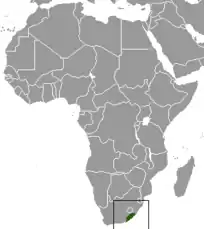Giant golden mole
The giant golden mole (Chrysospalax trevelyani) is a small mammal found in Africa. At 23 centimetres (9.1 in) in length, it is the largest of the golden mole species.[1] The mole has dark, glossy brown fur; the name golden comes from the Greek word for green-gold,[2] the family Chrysochloridae name.
| Giant golden mole | |
|---|---|
 | |
| Scientific classification | |
| Kingdom: | Animalia |
| Phylum: | Chordata |
| Class: | Mammalia |
| Order: | Afrosoricida |
| Family: | Chrysochloridae |
| Genus: | Chrysospalax |
| Species: | C. trevelyani |
| Binomial name | |
| Chrysospalax trevelyani (Günther, 1875) | |
Characteristics
The giant golden mole has a subterranean lifestyle.[2] It has large claws, powerful fore limbs, no external tail or ears, wedge-shaped head, leather pad, and skin covering the eyes. It is approximately 208-235 millimetres in length and 410-500 grams in weight.[2] With dark and brown skin on the upper parts and faded on the underparts,[1] the hair is longer and coarser than any other species of golden mole: thick, with dense, woolly underfur.[2]
Biology
The largest, rarest, and most endangered of all 17 species of golden moles,[3] the giant golden mole spends most of its time underground and is blind and deaf. It is nocturnal, hunting mostly at night, but also in some cool and cloudy daytime conditions.[2] It is solitary; it does not form groups, despite some social behavior such as hibernating in others' burrows among the roots of trees in winter, only moving slightly to keep its body temperature in range and twitching to maintain body temperature while sleeping.[3] Female Giant Golden moles give birth to one or two offspring at a time while it has stocks of food supply.
Diet
The giant golden mole digs semi-permanent tunnels for hunting food and may feed on the surface hiding in the leaf litter. It eats mainly millipedes and giant earthworms, but also crickets, cockroaches, grasshoppers, worms, and snails.[3]

Habitat
The giant golden mole is a subterranean small mammal, living in chambers and passages underneath a very specific habitat, forest with soft soils, deep leaf litter layers and well-developed undergrowth.[1] The giant golden mole is endemic to South Africa, mostly in a restricted area in the Eastern Cape.[4]
Population
Status
The giant golden mole was classified as Endangered (EN) in 2010 on IUCN Red List of Threatened Species. The population is decreasing[4] due to habitat loss resulting mainly from human activities affecting its habitat such as firewood collection, bark stripping, cutting for construction, overgrazing of livestock, and clearance of forest. Moreover, the giant golden mole is preyed on by domestic dogs in that area.[2][3]
Conservation
Nowadays, the giant golden mole receives little protection, and is not a main conservation target.[2] Research is needed to protect this species and to assess the status and viability of the remaining populations.
See also
References
- "EDGE of Existence". EDGE of Existence. Retrieved 2017-11-11.
- Bronner, G. "Giant golden mole (Chrysospalax trevelyani)". Arkive. Archived from the original on 2015-09-15. Retrieved 2017-11-11.
- ""Mole, Giant Golden." Endangered Species". www.encyclopedia.com. Retrieved 2017-11-11.
- Bronner, G. "Chrysospalax trevelyani (Giant Golden Mole)". IUCN Red List of Threatened Species. Retrieved 2017-11-11.
